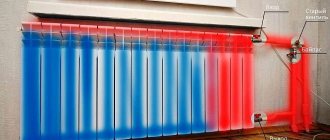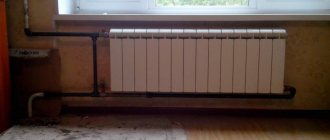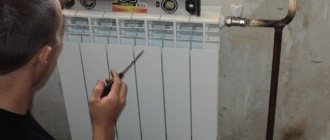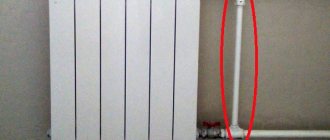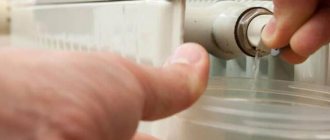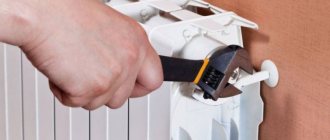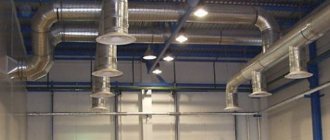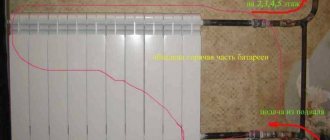When installing individual heating systems, users have to ensure their optimal functioning using various types of built-in equipment and plumbing fixtures. One of the main problems when operating a heating main is airing; in this case, homeowners need to independently solve the problem of how to bleed air from the heating system.
To simplify the de-airing procedure, at the installation stage of the system, technical devices for air release are built into the circuit and heat exchange devices. Also, proper maintenance and operation of the heating main plays a significant role in ensuring uninterrupted operation.
Rice. 1 Examples of individual heating boiler piping
How to bleed air from a radiator using an air vent
Valves will help bleed air from the radiators (they can be manual or automatic). Let's look at their types.
Mayevsky crane
A needle valve, the design of which includes a body and a cone-shaped screw - very tightly attached to each other, which helps prevent water leakage.
The faucet has a side hole that allows you to bleed air from the coolant using a screwdriver or a wrench from the kit (in some models, manually). When installing the Mayevsky tap, you need to ensure that the tube through which the air is removed looks straight down (but not into the wall!).
Note! For a cast iron radiator, you should choose an automatic air vent.
So, how do you bleed the air out of the radiator? Follow the following instructions:
- Take a wrench or a screwdriver, a rag and place some container under the tap.
- Turn off the pump.
- Begin to carefully turn the tap counterclockwise.
- The air from the radiator is unlikely to be clean.
- Close the tap after water flows from it.
Note! If the system uses low-quality water, then shut-off valves will not be superfluous. First, a valve is installed to prevent debris from accumulating, and then a tap is installed.
Automatic air vent
It helps to automatically bleed air from the coolant if it accumulates. The air vent has a brass body, float, articulated arm and valve. The locking cap is sealed, the spring-loaded protection does not allow debris into the system.
The operating principle of the system is as follows:
- Until it is necessary to bleed air from the radiator, the valve is covered with a float.
- In order to release air from the radiator, the float opens the valve.
- As the gas is removed, the air vent returns to its original position.
Remember! The automatic air vent has a hole for an octagonal wrench or screwdriver, through which, if a problem occurs, the air from the radiator can be vented manually.
Air separator
This device allows you to bleed air from radiators in stand-alone systems. An air separator removes gas accumulated in the system, converting it into bubbles. The device is used in conjunction with a sludge separator, which removes various pollutants from the water.
The system has the following form: a metal cylinder, on it there is an air vent, under it there is a valve for discharging sludge. In the inner part there is a metal mesh that creates vortex flows. Water passing through the system is filled with air bubbles, which rise and exit through the air vent. The remaining dirt is drained through the tap.
Knowing how to bleed air from the radiator will help prevent serious damage. Gas is also removed for “prevention”; this should be done twice (to make sure there is no gas). However, if there are malfunctions in the heating system, then you need to bleed the air from the coolant several times.
Read material on the topic: How to change a heating radiator without errors
Prevention
Experts recommend doing prophylaxis once a year. Typically this should happen at the beginning of the heating season. This is the only correct way to reliably avoid breakdowns and unnecessarily high heating costs.
For standardized heat exchangers, also called batteries, you need a small wrench with which you can open and close the vent valve. The diverter valve is located on the opposite side of the thermostat. For a heated towel rail in a bathroom, the valve is at the top (rear).
On the front part in the middle of the valve there is a square pin with which the element rotates. If the pin has a slot, you can also use a screwdriver instead of a square wrench. On the side of the valve is a small nipple or tube with a hole that allows water to flow out when opened.
If you have your own heating system or gas boiler in your apartment, you should turn off the circulation pump and wait one hour to allow any existing oxygen in the radiators to collect at the top. When the pump is turned on, it swirls in the system, reducing the likelihood of complete venting. If you cannot turn off the circulation pump yourself (for example, central heating), close the heating system of your apartment.
Once all heat exchangers have been ventilated, install the circulation pump again. If a lot of water is drained, the pressure in the heating system may decrease. If possible, check the pressure on the system gauge and, if necessary, increase the pressure by adding water.
There are several types of heating systems:
- manual. These devices are small in size and are installed on radiators indoors. It is enough to adjust them with a screwdriver or wrench. Due to low productivity, such air vents are used only for local removal within the apartment;
- automatic. Without outside interference. The devices are very effective, but very sensitive.
Bleeding air from heating devices
Before bleeding air from the radiator and from the system, you need to familiarize yourself with the features of this procedure and prepare tools and materials
It is important to understand how to bleed air from a battery correctly. You need to have a special key at your disposal that will help open the air valve on the battery. A radiator wrench is best suited for this type of work - you can buy it at a hardware store
A radiator wrench is best suited for this type of work - you can buy it at a hardware store.
If you have to work with a modern battery, then a simple screwdriver will do. You should also prepare a container for draining the coolant and several rags in case of an unforeseen situation.
Instructions for properly bleeding air from the battery look like this:
First, they inspect the battery and find a small valve (Maevsky tap). It is located at the top of the device; sometimes there are several such devices. Turn off the tap until air hisses.
You must act carefully and smoothly. Place a container under the valve
You should wait until all the accumulated air comes out. This is evidenced by a thin stream of water that has stopped bubbling.
According to some experts, you need to drain approximately 2 - 3 buckets after the coolant begins to drain without gases. This is necessary for reinsurance, so as not to carry out this procedure again. The valve is screwed back on.
In addition to the Mayevsky tap, you can bleed air from the battery using automated air vents. They are intended for heat supply systems and remove plugs independently.
These devices are compact and reliable, but care must be taken, because the valves are unattended and even a slight disruption of the process can lead to flooding of the basement or attic
Sometimes situations arise when, during the installation of the heating system, special products designed to eliminate air pollution were not installed. To release excess air from the device, you need a gas or adjustable wrench to unscrew the plug.
This work needs to be done slowly. If the plug does not unscrew, and such situations most often occur with cast iron radiators, a special lubricant should be applied to the threads. After a while the attempt is repeated. After you have managed to unscrew the plug, proceed in exactly the same way as with a regular tap.
At the end of the work, the plug is returned to its place, not forgetting to wrap flax or FUM tape around the thread, which will prevent leaks and ensure the tightness of the connection.
If air has collected in the heating system of a private house, the coolant is drained using an expansion tank. This container is located at the highest point of the heat supply structure. After draining the water, wait a little, then unscrew the tap on the tank.
As a rule, when the temperature in the battery rises, the plug is removed on its own. If the above actions are unsuccessful, then the water in the heating circuit must be brought to a boil and then the air will certainly escape.
Knowing how to bleed air from the radiator and system, you can avoid many problems. For preventive purposes, a similar procedure should be carried out before the start of the heating season. According to experts, two times (for verification and control) will be enough. If defects or breakdowns are found in the structure, then the number of descents may be greater.
Carrying out repair work
If you discover signs of air in the heating system, you should not immediately start getting rid of it. First, check the circuit for integrity and tightness. After all, if there are leaks, problems will continue.
Coolant leak
Coolant leakage is the loss of fluid that occurs due to loose connections and damage to the circuit.
Photo 1. Leak in the heating system pipe. Such a problem can cause poor operation of the heating structure.
Possible leak locations and solutions:
- Pipe sections. To stop the leak, clamps and cold welding are used. If the pipe is plastic, the entire section is replaced.
- The joints between parts of the system are sealed. Welding is used.
- Loose connection of radiator sections. You will have to remove the battery and tighten the connections (on aluminum). Cast iron radiators are glued with a cloth containing epoxy resin.
This is a labor-intensive part of the work of preparing the system for the heating season. But this must be done, otherwise you may be left without heat in winter.
A constant loss of coolant will lead to unstable operation of the system.
Features of the underfloor heating system
The presence of a heated floor complicates the system; it is not easy to remove air from the floor loops.
Air plugs appear due to:
- reducing pressure;
- strong heating of the coolant;
- leakage formation;
- violation of the tightness of connections;
- errors made during installation (uneven surface, pipe slope, errors in the organization of the collector);
- illiterate first launch of the system.
In order for the system to start correctly, the air is bled from it before the boiler is turned on and the coolant is heated.
If a warm floor is the main means of obtaining a comfortable temperature, then air should not be allowed into it.
Attention! A conventional system works even if there is air there. Efficiency will decrease, but heat will still flow
When air appears in the circuit, the floor will stop heating - the reason for this is the complex installation and small diameter of the pipeline.
Removing air from the floor circuit is a lengthy process:
- Only one circuit on the collector is turned on.
- The pressure is built up above the working pressure (15-20%).
- The circulation pump starts at low speed. It takes some time to fill the circuit so that the coolant displaces the air. Then the next circuit is activated, so one by one all the branches passing through the collector are slowly filled.
- The process lasts several days. This is repeated until all the air is released.
- This is done with cold coolant; heating is turned on only when it is certain that the air has completely escaped.
Reference. When installing the system, it is useful to think about equipping the floor circuit with a separator - a device for automatically removing air from the pipes.
Coolant renewal frequency
Liquid is an important component of heating that must be used correctly.
Periodic replacement is necessary, but should not be overused. The optimal shelf life of liquid in pipes is 12 months, subject to mandatory draining of the system.
Synthetic coolants: propylene glycol, ethylene glycol remain in the system for up to 7-8 years.
Photo 2. Canister with synthetic coolant for the heating system. This substance lasts longer than ordinary water.
The concentration of synthetic compounds in the liquid extends the shelf life of the coolant. But if there is no need to use antifreeze, then you can get by with plain water.
The replacement time will be determined by coarse filters: if they do not need to be washed and replaced, then the water in the system is also suitable and does not need to be changed.
This is important because each fresh portion of liquid is a fresh set of salts and impurities, oxygen, which reacts with new forces with internal surfaces, settling on them in layers that gradually reduce the efficiency of the system. Important! The water that is already in the circuit is a prepared liquid, without impurities and active substances
The fact that the water has changed color does not change its value - it has already undergone reactions, has become inert and is now an optimal addition to the efficiency of the system
Important! The water that is already in the circuit is a prepared liquid, without impurities and active substances. The fact that the water has changed color does not change its value - it has already undergone reactions, has become inert and is now an optimal addition to the efficiency of the system
If the radiators are clogged, you can remove them for cleaning without draining them; just turn off the valves.
What to pay attention to
Each heat exchanger has a release valve, which is usually located in the upper left or upper right corner of the heater. Install the key and turn counterclockwise. You must be slow and careful as there is pressure in the heating system. After a while, a hissing sound may appear. This means that air is being removed from the battery.
Water will start to come out of the heat exchanger, so you must remember to place a container or container underneath it. After a while, only water will come out of the valve. Then it should be turned back clockwise.
Those who have never done this themselves should pay special attention to safety: the water that comes out of the radiator can be very hot at some point. There is even a risk of scalding
What to do if there is air left
Sometimes after deflating the battery there is no necessary heating. You can fix the problem by blowing or washing the batteries.
You can fix the problem by thoroughly washing the battery.
With an autonomous system, it is necessary to check that it is completely filled. If the coolant is water, then expansion occurs quite quickly. When temperatures drop, water shortages occur.
If there is a need to drain water through the tank, it is necessary to disconnect the home from heating. The valves are pre-opened.
When the temperature rises, the plug comes out. If this does not happen, you need to boil the water. After this, the air will certainly come out.
What and how to bleed air from a heating radiator
In order to control the gas contamination of the system both in an apartment and in a private house, use a manual or automatic air release valve. They should be discussed in more detail.
- Automatic air valve;
- Air separator;
- Mayevsky crane.
The automatic air valve is capable of independently releasing air that has accumulated in the radiator. It consists of a brass body, float, articulated arm and valve. A special cap protects against leakage, and the protection located under the spring protects against the ingress of external contaminants.
The system works on the following principle:
- While there is no air, the float keeps the valve closed;
- As gas accumulates, the float begins to descend and gradually open the valve;
- The accumulation of air leaves the compartments, and the system returns to its original state.
It is important to note the fact that all automatic versions are equipped with connectors that are suitable for a screwdriver or octagonal keys. Thanks to this shape, you can open the valve even in manual mode if the automatic mode suddenly breaks down
As for the air separator, this system is a little more complicated. The principle of its operation is to absorb air, turn it into bubbles and remove it out. Most often, separators are combined with sludge, which is capable of trapping dirt, sand or rust. If we talk about the design, it is presented in the form of a metal cylinder, which includes an air vent at the top and a valve at the bottom, which serves to discharge foreign contaminants. Inside such an installation there is a mesh that creates a vortex flow.
The same method is used when there is a water circuit that is connected to heating. The release in the water supply is carried out as a bleed. That is, a stream of air or water with impurities can be released through the bleeder.
Reasons for airing the system
There are several fairly common reasons that provoke the appearance of an air lock inside heating structures:
- depressurization that occurred during scheduled maintenance or repair work;
- improper flushing or pressure testing of the system followed by filling the water circuit with standard coolant;
- local violation of the integrity of pipelines and radiator batteries under negative external influences or as a result of maintenance and operating errors;
- in private households - the absence of a sufficient pipe slope and expansion tank in the installed system;
- reduced pressure level in the water supply system, filling the resulting voids with air;
- faulty condition of air intake elements;
- connection to the heating structure of a “warm floor” system with pipes of different heights;
- air suction through leaky seam joints and joint areas;
- low quality coolant, oversaturation with gases;
- replenishing the volume of thermal fluid by adding cold tap water.
One of the most common problems is the presence of errors and errors at the stage of creating design documentation or installing pipework.
Bleeding air from heating radiators
Before bleeding air from the radiator and from the system, you need to familiarize yourself with the features of this procedure and prepare tools and materials
It is important to understand how to bleed air from a battery correctly. You need to have a special key at your disposal that will help open the air valve on the battery
A radiator wrench is best suited for this type of work - you can buy it at a hardware store.
If you have to work with a modern battery, then a simple screwdriver will do. You should also prepare a container for draining the coolant and several rags in case of an unforeseen situation.
Instructions for properly bleeding the battery:
First, they inspect the battery and find a small valve (Maevsky tap). It is located at the top of the device; sometimes there are several such devices. Turn off the tap until air hisses.
You must act carefully and smoothly. Place a container under the valve. You should wait until all the accumulated air comes out. This is evidenced by a thin stream of water that has stopped bubbling.
According to some experts, you need to drain approximately 2 - 3 buckets after the coolant begins to drain without gases. This is necessary for reinsurance, so as not to carry out this procedure again. The valve is screwed back on.
In addition to the Mayevsky tap, you can bleed air from the battery using automated air vents. They are intended for heat supply systems and remove plugs independently.
These devices are compact and reliable, but care must be taken, because the valves are unattended, and even a slight disruption of the process can lead to flooding of the basement or attic.
Sometimes situations arise when, during the installation of the heating system, special products designed to eliminate air pollution were not installed. To release excess air from the device, you need a gas or adjustable wrench to unscrew the plug.
This work needs to be done slowly. If the plug does not unscrew, and such situations most often occur with cast iron radiators, a special lubricant should be applied to the threads. After a while the attempt is repeated. After you have managed to unscrew the plug, proceed in exactly the same way as with a regular tap.
At the end of the work, the plug is returned to its place, not forgetting to wrap flax or FUM tape around the thread, which will prevent leaks and ensure the tightness of the connection.
If air has collected in the heating system of a private house, the coolant is drained using an expansion tank. This container is located at the highest point of the heat supply structure. After draining the water, you should wait a little, then unscrew the tap on the tank.
As a rule, when the temperature in the battery rises, the air lock is removed on its own. If the above actions are unsuccessful, then the water in the heating circuit must be brought to a boil and then the air will certainly escape.
Knowing how to bleed air from the radiator and system, you can avoid many problems. For preventive purposes, a similar procedure should be carried out before the start of the heating season. According to experts, two times (for verification and control) will be enough. If defects or breakdowns are found in the structure, then the number of descents may be greater.
Method two
Algorithm:
- After starting, the engine is given about fifteen minutes to run, and then it turns off;
- The tank is “freed” from the elements;
- Without removing the cover, any of the pipes is disconnected. If there was excess air, it will come out;
- The pipe is put in place after the antifreeze liquid begins to flow.
How can you avoid the formation of an air lock?
How can you remove air?
The ideal option is when, during installation of the heating system, a special Mayevsky valve is built into each radiator, with which you can bleed air from each radiator separately.
You can also use an automatic air vent, which will autonomously control the entire heating system. Even with a perfectly functioning heating system, you will still have to periodically bleed the air from the batteries, but this will not cause much difficulty.
While filling the system, try to control the water pressure and temperature of the radiators. If suddenly the water pressure begins to drop sharply, it means that the seal of the battery has been broken somewhere. If the temperature of the batteries is not stable, look for an air lock in the heating system.
If your batteries are equipped with automatic air vents, then you can rest easy: they will do all the necessary work for you to eliminate air from the radiators. If the batteries are equipped with small manual taps, then you need to carry out the entire procedure for removing air from the heating radiator yourself.
Another important point is the pipeline itself. Quite often, an air lock can form in very difficult places in the pipeline, where there are many bends, turns or incorrect slopes. In such areas it is necessary to install additional air vents.
How to bleed air from a battery?
In order to remove air from the battery, you need to use a special Mayevsky tap, which is designed specifically for this.
Prepare a bucket for water in advance. In the upper right corner of the radiator you will find the Mayevsky tap, which must be unscrewed with a special key or a regular screwdriver. Don't forget to place a container where the water will drain.
Listen to the sounds that the battery makes: first you will hear a slight hissing sound, which indicates that there is indeed air in the battery, which means that you are doing everything correctly. Now water should drip from the battery, wait until the water runs in a thin stream and screw the tap into place.
There are times when eliminating the air lock in the batteries did not bring any results, and the radiators still remain cold, then it is necessary to thoroughly rinse and blow out the battery.
If this procedure does not yield anything, you need to look for the problem in the heating system itself.
We hope that the material was useful to you. If it’s not too much trouble, please click the social media buttons so that others can read this article.
Have a nice day!
Very important information
Below we will describe situations when one or another inclusion of the battery may be undesirable, and sometimes unacceptable!
4.1.You cannot use the thermostat without a jumper
In point 2 we talked about the thermostat. However, you need to understand that experiments with a temperature controller are only possible with a jumper! If it is not there, and you reduce the diameter of the flow pipe, then the total flow of hot water through your apartment will decrease. Which of course is unacceptable, otherwise your neighbors will come to you!
4.2. The thermostat may become clogged
If you are using a jumper, but for some reason it was turned off for a while and the thermostat was set to position 5, i.e. provided a full flow of hot water only through the battery, as shown in the figure:
then everything seems to be fine. However, we must accept reality as it is. Even if we turned on the central heating radiators correctly for the first time, there is no guarantee that, for example, in a month or two a new mud flow will not pass through the pipes. But then, if the jumper is turned off, then the splash of dirt will go straight to your thermostat, which, in fact, is very sensitive to it. As a result, a blockage forms in the thermostat, and water will not flow into the battery at all. It won’t go into the jumper either, because you closed it. Therefore, in this situation, water will stop flowing through your apartment; in the house, through your heating riser, the water will also stop and begin to cool in the cold. As a result, a squad of evil neighbors, together with the chairman of the HOA or housing cooperative, is guaranteed to enter your apartment.
It is clear that switching on according to the above figure is similarly not acceptable for the regulator positions 4,3,2,1,*
4.3. The jumper must always be on
Make it a rule that it doesn’t matter whether you use a temperature controller or not, but the jumper should always be on. Thus, you will always ensure the flow of hot water through your apartment
When does it make sense to turn off the jumper? For example, when you feel that the battery is clogged. Then you let all the water flow through the battery by disconnecting the jumper. Perhaps a more powerful stream of hot water will be able to push through the stuck dirt. But this needs to be done for a short time and only under your control - you cannot leave the situation like this and go to sleep. The fact is that if the dirt cannot be pushed through, then a congestion will form again: water will not be able to pass through either the battery or the jumper.
This is mega important, because if it is installed before the jumper, then when you first turn it on, dirt will definitely clog your thermostat, and you will start the heating season with a complete rewiring of the battery:
Application of the Mayevsky crane
Air can be released using special removable handles. They are put on the inside of the valve, which is made of metal. If such a handle is missing, it must be replaced with a notch for a screwdriver.
Mayevsky crane - a convenient device
How to properly remove air from a heating system?
- Place a container under the tap (volume – 500-1000 ml).
- Open the tap. Wait until the air comes out. Then a characteristic hiss will appear, indicating the flow of air mixed with water.
- Wait until clean water comes out.
- Close the tap.
If there is no handle, you will need to use a screwdriver or wrench. You can use a gas or adjustable wrench
If the tap is screwed on very tightly, you need to act carefully. Otherwise, you can rip it off, the consequences of which can be catastrophic.
The instructions are:
- Wrap the surface of the radiator. Use a rag or rags. Place a container to allow liquid to drain out.
- Turn off the tap and wait for the hiss to appear.
- Wait for the water to drain out.
- Drain the water (up to 2000 ml).
- Turn on the tap.
- Wait 10-12 minutes.
- Turn off the tap and make sure that the air comes out completely.
- If this does not happen, you need to repeat the procedure.
Plug on the battery
If the tap is missing, and instead there is a Soviet-style plug, you need to proceed as follows:
- Wrap the desired area with thick fabric. You can use rags. This will eliminate the risk of high pressure.
- “Arm yourself” with a converter (can be replaced with a solvent).
- Carefully turn the plug. There is no need to take it out completely, otherwise there will be a “flood” in the apartment.
- Wait for the air masses to come out. The flow can be felt by placing your hand near the plug.
- Wait until the water flows out (3000-5000 ml).
- “Arm yourself” with fum tape and wrap the plug. The required direction is against the thread. This provides the necessary tightness.
- Screw the plug as tightly as possible.
For individual heating, you can use an expansion tank.
If you have individual heating at home, you can get rid of the problem using an expansion tank. They can be open or closed.
In the first case, we may be talking about a decrease in the coolant or water level. They should be added to the system. It is advisable to use the bottom valve. The radiator can be absolutely anything. If this is not possible, you will need to use a tank.
After removing the air lock, it is necessary to start the system. She should do a good job. If the plug remains, it is drained using the radiator.
If the type of tank is closed, then you first need to check its functionality.
First method
The actions are performed in the following order:
- The expansion tank is “released”, where cooling liquid is present. To do this, all elements are completely removed from it;
- Any of the pipes must be disconnected;
- The lid is removed from the tank and it is covered with a piece of cloth;
- Now you need to blow inside the tank to create a certain pressure. This will allow excess air to escape from the pipe;
- When the antifreeze starts to come out, the pipe is put on it and fixed with a clamp;
- The tank lid is closed, and all elements are installed in their places.
